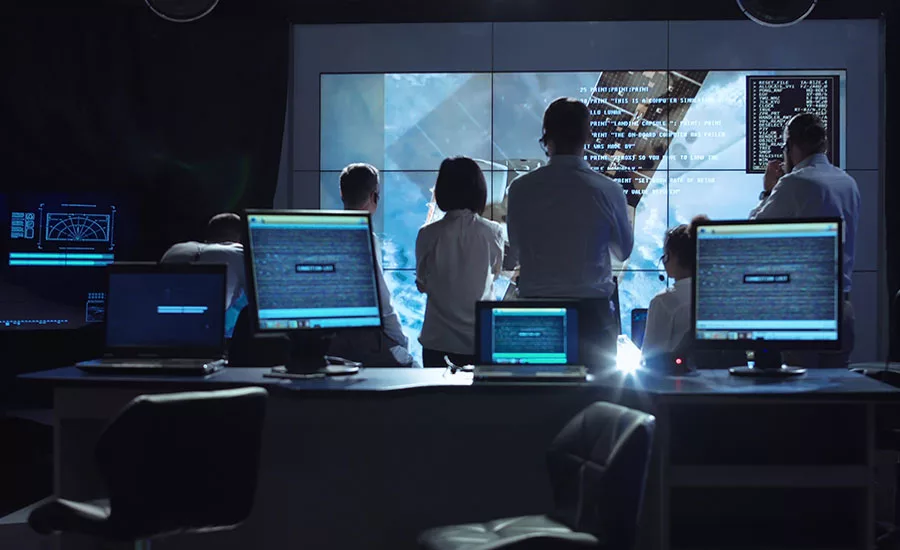Primary Considerations and Pitfalls for Security Control Room Design
Developing an effective SOC requires more than just the streamlining of physical security systems

So, you’ve come to the juncture of your security program where you’ve determined that the best course of action to improve the safety of your employees and stakeholders is to build a security operations center, or SOC for short, to help give you a comprehensive view of your operations across the enterprise. After making the decision to create a command center, you consult your security integrator to determine how your systems can be tied together in a central location, what software platforms will be needed to ensure that they function properly together, and where to hang your shiny new video wall. Problem solved, right?
The fact is there are a number of different factors that organizations seeking to build an SOC need take into consideration beyond what video surveillance, access control and emergency communications technologies they will contain. First and foremost, organizations must think about who is going to staff the center and whether they have the prerequisite abilities to carry out the necessary functions of the facility.
Beyond determining who will staff it, you will need to decide what kind of authority operators in the SOC will have to make decisions that could mean the difference between life and death depending on the situation. And, perhaps just as importantly, you will need to consult an integrator who specializes in the development of security command centers to not only figure out the types of audio/visual (A/V) technology and technical furniture that will be required for the project, but also how the equipment will need to be arranged within the command center.
Hiring a Control Room Integrator
Consulting with a specialized integrator that has experience in designing and deploying SOCs is a critical step every organization must make early in the building process so the integrator can provide recommendations about the systems that will best support the operations of the center and enhance the responsiveness of those who will staff it. Just as the rest of your security operations require an integrator with specialized knowledge in physical security technology, command centers and the systems deployed within them demand professionals with the proper expertise to install them as well. And even though the background of a control room integrator may be in traditional A/V systems, many have become certified in the types of critical, 24/7 systems used in SOC environments, making them a true part of the security ecosystem.
Ergonomics Are Key
Though many security managers tend to have tunnel vision on the techy aspects of building a SOC, often the most important things to consider are the most basic and in a command center environment, that begins with an operator-centric design. The primary goal of every SOC is to enhance communication and responsiveness during security incidents, but that cannot be achieved unless the jobs of operators are made easier and more efficient by the tools around them.
This means ensuring things, such as furniture, lighting and HVAC systems are all properly aligned from the operator perspective. For example, you don’t want people managing four different keyboards and mice to access different systems, so ensuring that consoles are ergonomic in nature by having streamlined equipment that are within arm’s reach with well-positioned sightlines is paramount. Even something that may seem as fundamental as lighting should be tailored to the needs of your operators. Making a room too dark, for instance, may promote fatigue and sleep, while making it artificially bright could cause eyestrain and potentially introduce more heat into the space.
Special attention should also be paid to what information is displayed on the command center’s video wall. The video wall, which is essentially the core component of every SOC, should provide additional information beyond what an operator may have in front of them at their workstation and supply a common operational picture that anyone within the center can digest within 15 to 20 seconds.
Unfortunately, some organizations opt to deploy office-grade furniture and systems that are more suited for corporate boardroom and office environments than they are mission-critical SOCs. Technical furniture should be designed to suit operators who work long shifts and need to stay alert. That’s another reason why consulting a control room integrator early in the process is key to avoiding an uneven or ham-fisted install.
Pitfalls to Avoid
Just as there are things that need to be taken into consideration for the build-out of an effective command center, end users should also be on the lookout for several pitfalls. Chief among these is lack of scalability. Let’s say you get your SOC up and running, and then a year from now there is a new software application you want to run or additional cameras you need to integrate, but you lack the capability to do so because adequate scalability wasn’t baked into the original design. It is critical that security managers talk to employees and other stakeholders to understand what types of future capabilities may be required of their SOCs.
You also want to benchmark the best by talking to like-minded people within your organization or field to learn some of the mistakes they’ve made along the way and where they’ve found success. Without talking to your contemporaries, you’re rolling the dice with the success of your command center.
2). What are the roles of our operators? These are the people who will be depended upon during an emergency to communicate with relevant employees and stakeholders, so it is crucial to clearly define their roles and responsibilities. For example, how much autonomy will they have to make decisions? Will they be a contract worker from a guard service or an in-house employee?
Looking for a reprint of this article?
From high-res PDFs to custom plaques, order your copy today!








